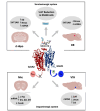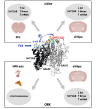A New Augmentation Strategy against Depression Combining SSRIs and the N-terminal Fragment of Galanin (1-15)
- PMID: 39484753
- PMCID: PMC11808584
- DOI: 10.2174/1570159X23666241003125019
A New Augmentation Strategy against Depression Combining SSRIs and the N-terminal Fragment of Galanin (1-15)
Abstract
Depression is one of the most disabling mental disorders, with the second highest social burden; its prevalence has grown by more than 27% in recent years, affecting 246 million in 2021. Despite the wide range of antidepressants available, more than 50% of patients show treatment-resistant depression. In this review, we summarized the progress in developing a new augmentation strategy based on combining the N-terminal fragment of Galanin (1-15) and SSRI-type antidepressants in animal models.
Keywords: Depression; GAL(1-15); SSRIs; animal models; antidepressants.; augmentation therapy.
Copyright© Bentham Science Publishers; For any queries, please email at epub@benthamscience.net.
Conflict of interest statement
The authors declare no conflict of interest, financial or otherwise.
Figures



Similar articles
-
Galanin (1-15) enhancement of the behavioral effects of Fluoxetine in the forced swimming test gives a new therapeutic strategy against depression.Neuropharmacology. 2017 May 15;118:233-241. doi: 10.1016/j.neuropharm.2017.03.010. Epub 2017 Mar 11. Neuropharmacology. 2017. PMID: 28288814
-
Risk of suicidality in depression with serotonergic antidepressants.Ann Clin Psychiatry. 2000 Mar;12(1):43-50. doi: 10.1023/a:1009027010991. Ann Clin Psychiatry. 2000. PMID: 10798825 Review.
-
[SSRI resistant depression. Supplementation with noradrenergic pharmaceuticals can be a good alternative].Lakartidningen. 2004 Sep 2;101(36):2712-4. Lakartidningen. 2004. PMID: 15455633 Swedish.
-
Treatment of antidepressant nonresponders: augmentation or switch?J Clin Psychiatry. 1998;59 Suppl 15:35-41. J Clin Psychiatry. 1998. PMID: 9786309 Review.
-
Use of selective serotonin-reuptake inhibitors in the treatment of depression in adults with HIV.Ann Pharmacother. 2005 Jan;39(1):141-5. doi: 10.1345/aph.1E248. Epub 2004 Nov 23. Ann Pharmacother. 2005. PMID: 15562140 Review.
References
-
- Depression and other common mental disorders. 2017 Available from: https://www.who.int/publications/i/item/depression-global-health-estimates.
-
- Santomauro D.F., Mantilla H.A.M., Shadid J., Zheng P., Ashbaugh C., Pigott D.M., Abbafati C., Adolph C., Amlag J.O., Aravkin A.Y., Bang-Jensen B.L., Bertolacci G.J., Bloom S.S., Castellano R., Castro E., Chakrabarti S., Chattopadhyay J., Cogen R.M., Collins J.K., Dai X., Dangel W.J., Dapper C., Deen A., Erickson M., Ewald S.B., Flaxman A.D., Frostad J.J., Fullman N., Giles J.R., Giref A.Z., Guo G., He J., Helak M., Hulland E.N., Idrisov B., Lindstrom A., Linebarger E., Lotufo P.A., Lozano R., Magistro B., Malta D.C., Månsson J.C., Marinho F., Mokdad A.H., Monasta L., Naik P., Nomura S., O’Halloran J.K., Ostroff S.M., Pasovic M., Penberthy L., Reiner R.C., Jr, Reinke G., Ribeiro A.L.P., Sholokhov A., Sorensen R.J.D., Varavikova E., Vo A.T., Walcott R., Watson S., Wiysonge C.S., Zigler B., Hay S.I., Vos T., Murray C.J.L., Whiteford H.A., Ferrari A.J. Global prevalence and burden of depressive and anxiety disorders in 204 countries and territories in 2020 due to the COVID-19 pandemic. Lancet. 2021;398(10312):1700–1712. doi: 10.1016/S0140-6736(21)02143-7. - DOI - PMC - PubMed
Publication types
MeSH terms
Substances
Grants and funding
LinkOut - more resources
Full Text Sources
Medical

